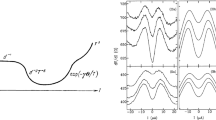Abstract
We propose a confinement potential for electrons in a two-dimensional (2D) quantum dot that is more physically motivated and better experimentally justified than the commonly used infinite range parabolic potential or few other choices. Because of the specific experimental setup in a 2D quantum dot involving application of gate potentials, an area of electron depletion is created near the gate. The resulting positively charged region can be most simply modeled as a uniformly charged 2D disk of positive background charge. Within this experimental setup, the individual electrons in the dot feel a confinement potential originating from the uniformly positively charged 2D background disk. Differently from the infinitely high parabolic confinement potential, the resulting 2D charged disk potential has a finite depth. The resulting 2D charged disk potential has a form that can be reasonably approximated as a parabolic potential in the central region of the dot (for low energy states of the electrons) and as a Coulomb potential (that becomes zero at large distances). We study the electronic properties of the 2D charged disk confinement potential by means of the numerical diagonalization method and compare the results to the case of 2D quantum dots with a pure parabolic confinement potential.
Similar content being viewed by others
References
Jacak L., Hawrylak P., Wojs A. (1997) Quantum Dots. Springer, Berlin
Tarucha S., Austing D.G., Honda T., van der Hage R.J., Kouwenhoven L.P. (1996). Shell filling and spin effects in a few electron quantum dot. Phys. Rev. Lett. 77, 3613–3616
Ashoori R.C., Stormer H.L., Weiner J.S., Pfeiffer L.N., Baldwin K.W., West K.W. (1993). N-electron ground state energies of a quantum dot in magnetic field. Phys. Rev. Lett. 71, 613–616
Maksym P.A., Chakraborty T. (1990). Quantum dots in a magnetic field: Role of electron-electron interactions. Phys. Rev. Lett. 65, 108–111
Merkt U., Huser J., Wagner M. (1991). Energy spectra of two electrons in a harmonic quantum dot. Phys. Rev. B 43, 7320–7323
Pfannkuche D., Gerhardts R.R. (1991). Quantum-dot helium: Effects of deviations from a parabolic confinement potential. Phys. Rev. B 44, 13132–13135
MacDonald A.H., Johnson M.D. (1993). Magnetic oscillations of a fractional Hall dot. Phys. Rev. Lett. 70, 3107–3110
Pfannkuche D., Gudmundsson V., Maksym P.A. (1993). Comparison of a Hartree, a Hartree-Fock, and an exact treatment of quantum-dot helium. Phys. Rev. B 47, 2244–2250
Yannouleas C., Landman U. (2000). Collective and independent-particle motion in two-electron artificial atoms. Phys. Rev. Lett. 85, 1726–1729
Tavernier, M.B., Anisimovas, E., Peeters, F.M.: Correlation between electrons and vortices in quantum dots. Phys. Rev. B 70, 155321-1–155321-8 (2004).
Tavernier, M.B., Anisimovas, E., Peeters, F.M., Szafran, B., Adamowski, J., Bednarek, S.: Four-electron quantum dot in a magnetic field. Phys. Rev. B 68, 205305-1–205305-9 (2003).
Drouvelis, P.S., Schmelcher, P., Diakonos, F.K.: Probing the shape of quantum dots with magnetic fields. Phys. Rev. B 69, 155312-1–155312-5 (2004).
Drouvelis P.S., Schmelcher P., Diakonos F.K. (2003). Two-electron anisotropic quantum dots. Europhys. Lett. 64, 232–238
Maksym P.A. (1996). Eckardt frame theory of interacting electrons in quantum dots. Phys. Rev. B 53, 10871–10886
Bolton F. (1996). Fixed-phase quantum Monte Carlo method applied to interacting electrons in a quantum dot. Phys. Rev. B54, 4780-4793
Kainz, J., Mikhailov, S.A., Wensauer, A., Rössler, U.: Quantum dots in high magnetic fields: Calculation of ground state properties. Phys. Rev. B 65, 115305-1–115305-5 (2002).
Harju, A., Siljamäki, S., Nieminen, R.M.: Wigner molecules in quantum dots: A quantum Monte Carlo study. Phys. Rev. B 65, 075309-1–075309-6 (2002).
Partoens B., Peeters F.M. (2000). Molecule-type phases and Hund’s rule in vertically coupled quantum dots. Phys. Rev. Lett. 84, 4433–4436
Adamowski J., Sobkowicz M., Szafran B., Bednarek S. (2000). Electron pair in a Gaussian confining potential. Phys. Rev. B 62, 4234–4237
De Filippo S., Salerno M. (2000). Spectral properties of a model potential for quantum dots with smooth boundaries, Phys. Rev. B 62, 4230–4233
Stopa M (1996). Quantum dot self-consistent electronic structure and the Coulomb blockade. Phys. Rev. B 54, 13767–13783
Ciftja, O., Wexler, C.: Monte Carlo simulation method for Laughlin-like states in a disk geometry. Phys. Rev. B 67, 075304-1–075304-8 (2003).
For the definition of complete elliptic integral of the second kind and hypergeometric functions, see Chapter 5 and Chapter 13 of: Mathematical Methods For Physicists, Fifth Edition, George B. Arfken and Hans J. Weber, Academic Press (2001).
Ciftja, O., Anil Kumar, A.: Ground state of two-dimensional quantum-dot helium in zero magnetic field: Perturbation, diagonalization, and variational theory. Phys. Rev. B 70, 205326-1–205326-8 (2004).
Ciftja, O., Faruk, M.G.: Two-dimensional quantum-dot helium in a magnetic field: Variational theory. Phys. Rev. B 72, 205334-1–205334-10 (2005).
Petta, J.R., Johnson, A.C., Yacoby, A., Marcus, C.M., Hanson, M.P., Gossard, A.C.: Pulsed-gate measurements of the singlet-triplet relaxation time in a two-electron double quantum dot. Phys. Rev. B 72, 161301-1–161301-4(R) (2005).
A. C. Johnson, J. R. Petta, C. M. Marcus, M. P. Hanson, and A. C. Gossard, Singlet-triplet spin blockade and charge sensing in a few-electron double quantum dot. Phys. Rev. B 72, 165308-1–165308-7 (2005).
Mourokh, L.G., Smirnov, A.Y.: Negative differential conductivity and population inversion in the double-dot system connected to three terminals. Phys. Rev. B 72, 033310-1–033310-4 (2005).
Helle, M., Harju, A., Nieminen, R.M.: Two-electron lateral quantum-dot molecules in a magnetic field. Phys. Rev. B 72, 205329-1–205329-24 (2005).
Author information
Authors and Affiliations
Corresponding author
Rights and permissions
About this article
Cite this article
Ciftja, O. An experimentally justified confining potential for electrons in two-dimensional semiconductor quantum dots. J Computer-Aided Mater Des 14, 37–44 (2007). https://doi.org/10.1007/s10820-006-9035-8
Published:
Issue Date:
DOI: https://doi.org/10.1007/s10820-006-9035-8




